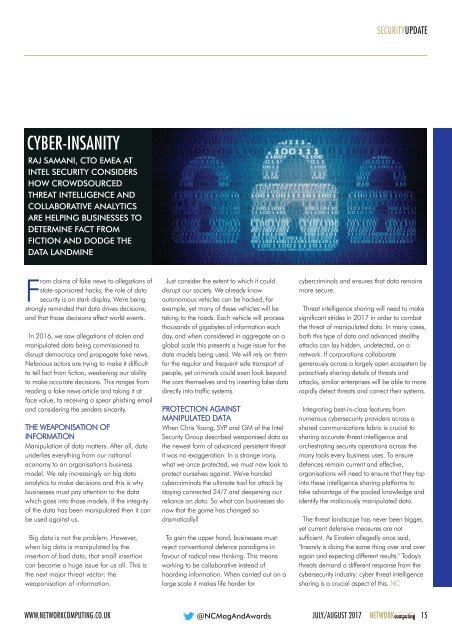You also want an ePaper? Increase the reach of your titles
YUMPU automatically turns print PDFs into web optimized ePapers that Google loves.
SECURITYUPDATE<br />
CYBER-INSANITY<br />
RAJ SAMANI, CTO EMEA AT<br />
INTEL SECURITY CONSIDERS<br />
HOW CROWDSOURCED<br />
THREAT INTELLIGENCE AND<br />
COLLABORATIVE ANALYTICS<br />
ARE HELPING BUSINESSES TO<br />
DETERMINE FACT FROM<br />
FICTION AND DODGE THE<br />
DATA LANDMINE<br />
From claims of fake news to allegations of<br />
state-sponsored hacks, the role of data<br />
security is on stark display. We're being<br />
strongly reminded that data drives decisions,<br />
and that those decisions affect world events.<br />
In 2016, we saw allegations of stolen and<br />
manipulated data being commissioned to<br />
disrupt democracy and propagate fake news.<br />
Nefarious actors are trying to make it difficult<br />
to tell fact from fiction, weakening our ability<br />
to make accurate decisions. This ranges from<br />
reading a fake news article and taking it at<br />
face value, to receiving a spear phishing email<br />
and considering the senders sincerity.<br />
THE WEAPONISATION OF<br />
INFORMATION<br />
Manipulation of data matters. After all, data<br />
underlies everything from our national<br />
economy to an organisation's business<br />
model. We rely increasingly on big data<br />
analytics to make decisions and this is why<br />
businesses must pay attention to the data<br />
which goes into those models. If the integrity<br />
of the data has been manipulated then it can<br />
be used against us.<br />
Big data is not the problem. However,<br />
when big data is manipulated by the<br />
insertion of bad data, that small insertion<br />
can become a huge issue for us all. This is<br />
the next major threat vector: the<br />
weaponisation of information.<br />
Just consider the extent to which it could<br />
disrupt our society. We already know<br />
autonomous vehicles can be hacked, for<br />
example, yet many of these vehicles will be<br />
taking to the roads. Each vehicle will process<br />
thousands of gigabytes of information each<br />
day, and when considered in aggregate on a<br />
global scale this presents a huge issue for the<br />
data models being used. We will rely on them<br />
for the regular and frequent safe transport of<br />
people, yet criminals could even look beyond<br />
the cars themselves and try inserting false data<br />
directly into traffic systems.<br />
PROTECTION AGAINST<br />
MANIPULATED DATA<br />
When Chris Young, SVP and GM of the Intel<br />
Security Group described weaponised data as<br />
the newest form of advanced persistent threat<br />
it was no exaggeration. In a strange irony,<br />
what we once protected, we must now look to<br />
protect ourselves against. We've handed<br />
cybercriminals the ultimate tool for attack by<br />
staying connected 24/7 and deepening our<br />
reliance on data. So what can businesses do<br />
now that the game has changed so<br />
dramatically?<br />
To gain the upper hand, businesses must<br />
reject conventional defence paradigms in<br />
favour of radical new thinking. This means<br />
working to be collaborative instead of<br />
hoarding information. When carried out on a<br />
large scale it makes life harder for<br />
cybercriminals and ensures that data remains<br />
more secure.<br />
Threat intelligence sharing will need to make<br />
significant strides in 2017 in order to combat<br />
the threat of manipulated data. In many cases,<br />
both this type of data and advanced stealthy<br />
attacks can lay hidden, undetected, on a<br />
network. If corporations collaborate<br />
generously across a largely open ecosystem by<br />
proactively sharing details of threats and<br />
attacks, similar enterprises will be able to more<br />
rapidly detect threats and correct their systems.<br />
Integrating best-in-class features from<br />
numerous cybersecurity providers across a<br />
shared communications fabric is crucial to<br />
sharing accurate threat intelligence and<br />
orchestrating security operations across the<br />
many tools every business uses. To ensure<br />
defences remain current and effective,<br />
organisations will need to ensure that they tap<br />
into these intelligence sharing platforms to<br />
take advantage of the pooled knowledge and<br />
identify the maliciously manipulated data.<br />
The threat landscape has never been bigger,<br />
yet current defensive measures are not<br />
sufficient. As Einstein allegedly once said,<br />
"Insanity is doing the same thing over and over<br />
again and expecting different results." Today's<br />
threats demand a different response from the<br />
cybersecurity industry: cyber threat intelligence<br />
sharing is a crucial aspect of this. NC<br />
WWW.NETWORKCOMPUTING.CO.UK @NCMagAndAwards<br />
JULY/AUGUST 2017 NETWORKcomputing 15

















